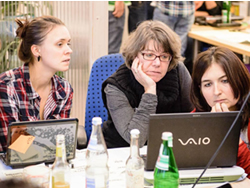Laura Stack has found research showing that some of the best ideas occur when people of different specialisation come together — even though they might not be the ideas initially wanted.
 In agriculture, cross-pollination occurs when pollen from one field of crops interacts with another, creating hybrids.
In agriculture, cross-pollination occurs when pollen from one field of crops interacts with another, creating hybrids.
This is often deliberate, as a form of experimentation when trying to create new crops.
However, it just as often occurs naturally when genetically modified crops cross-pollinate and fertilise traditionally modified crops.
Scientists have long since learned that mixing experts in multiple disciplines can ‘cross-pollinate’ and spark new ideas.
In recent years, the concept of cross-pollination of ideas has taken hold in business.
Rather than compartmentalise their employees in rigid sections, some organisations and think-tanks have taken to mixing people from a variety of fields and allowing them regular contact.
The intent is to apply ideas from as many fields as possible to the problems at hand, just in case something unexpected applies.
You can personally apply cross-pollination from multiple fields to your own teamwork by absorbing knowledge in many fields.
How will this increase your personal productivity?
It puts your subconscious to work:
The subconscious mind excels at the grubby job of taking bits and pieces of ideas and fitting them together into practical, even revolutionary new solutions.
Elias Howe was supposed to have invented the first truly practical sewing machine in the 1840s after a nightmare in which savages surrounded him with holes in their upright spear-points that bobbed up and down in sequence.
Similarly, Friedrich August Kekulé deduced the ring-structure of the benzine molecule after dreaming of a snake swallowing its tail.
After studying subconscious solutions like these, numerous scholars and ‘life-hackers’ have come up with ways to encourage the subconscious mind to help solve problems.
Everything is grist for the mill:
I recommend keeping your eyes wide open, because you never know what might boost your productivity.
A fast-food manager picked up the drive-thru idea as he used a bank’s drive-thru night deposit window.
While wrestling with how to finish a scholarly paper on an esoteric subject, a colleague took a break to read a chapter or two of a novel, clearing his mental palate.
A discussion of how experts cut diamonds with tiny, precise blows after a careful study of their flaws helped him find the ending he needed.
This isn’t uncommon; often a minor plot point or throwaway idea by one writer stimulates a story idea in another, which is why most writers read a lot.
White-collar cross-pollination has existed for decades now, though it’s not as popular as it once was.
An influential 2004 study of 17,000 business patents demonstrated that the farther apart a set of colleagues’ disciplines were, the less likely they would produce the quality innovation required.
However, the ideas they did produce proved “of unusually high value — superior to the best innovations achieved by conventional approaches”.
It aids the diffusion of ideas:
Not all ideas cross-pollinate. In fact, very few do.
However, a 2010 paper in the Annales d’Economie et Statistique shows cross-pollination allows for a more democratic flow of ideas, especially once commercial firms get involved.
This shouldn’t surprise anyone since it unlocks the limitation keeping most research stuck in scientific journals 99 per cent of which the public never sees, increasing the audience and potential for cross-pollination.
You never know which little fragments the subconscious will lock together.
The Law of Unexpected Consequences:
For every dollar spent on the United States space program, many more enter the economy via new inventions.
These include spin-off technologies like quick-cool ceramics, infrared ear thermometers, space blankets, building shock absorbers, visual enhancement systems, memory foam — the list goes on.
Open yourself to the ability to work with anyone and suck up knowledge like a sponge.
*Laura Stack is a keynote speaker and author on productivity and performance. She has authored seven books, including her newest work, Doing the Right Things Right: How the Effective Executive Spends Time. She can be contacted at theproductivitypro.com.
This article first appeared on Laura’s blogsite.


